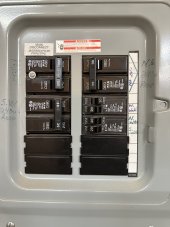RickRoades
New Member
I’m new so my logic is likely not complete or sound, advice welcomed. I purchased the EG4 6500EX-48 and 1 EG4 LL battery, for now. Staged goals are based having a portable dual fuel generator w/ propane (1000 gal tank) and hook up
What don’t I know?
Thanks in advance.
Rick
- Power outage back up for food refrigeration (Several), some lights and computers for work, extension cords at first. Recharge battery with generator using Chargeverter, extending fuel and coverage for the outages, no solar panels yet.
- Added convenience in outages, using a manual transfer switch from battery -> switch -> main, leaving on Line until the outage, still no solar panels
- solar panels will be last as have yet to find best place for a ground mount while hoping not to advertise having them. Will likely involve dozer/landscaping etc.
| Transfer switch, 10 circuit? | plan to add 2nd EG4 6500ex | 240v lower priority | |
| 50 or 30 amp Cord and plug? | 1 EG4 = 120v, 50 amp switch is 240v plug | Use this with only wired for 120v? | |
| 6500ex can do 50 amps | understood that battery would drain quickly, but the point is to not have to rewire in the future beyond adding the inverter or more batteries, and don’t intend to pull 50 amps, just thinking about capability | ||
| Cutting electric grid usage | With solar | run daytime circuits on battery/inverter | Night time on LINE as needed |
| With solar and additional batteries | Run some circuits more permanently | Can still charge with generator | |
| Added inverter to above | Run AC and/or most on solar | ||
| Take it with me if we move | nothing permanently installed | Switch is easy, just unhook from panel | Solar panels stable mount but not permanent, possibly something like the EG4 ground mounts |
What don’t I know?
Thanks in advance.
Rick



